Seder Olam Revisited: C34- Diaspora
- Albert Benhamou
- Sep 28
- 31 min read
Updated: Oct 7
CHRONOLOGY OF JEWISH HISTORY
Generation 34: Hebrew years 3960-4080 (200-320 CE)
Previous page < Navigation > Next page
To return to the list of chronological generations from Seder Olam Revisited, click here.
Introduction
This 34th chronological generation sees the establishment of Jews in Diaspora across the Roman empire. And, at the end of this generation, the empire authorizes Christianity as a religion.
Hebrew Year | CE | Event | Source |
3960 | 200 | Emperor Septimius Severus | Historia Augusta, Severus |
3971 | 211 | Emperor Caracalla | |
3972 | 212 | Edict of Caracalla | Herodian, Roman History, 4 |
3977 | 217 | Death of Judah the Saint | |
3982 | 222 | Emperor Alexander Severus | Historia Augusta, Severus Alexander |
3995 | 235 | Crisis of the Third Century | |
4000 | 240 | New millennium in Hebrew calendar | |
4000 | 240 | Sefer Yetzirah (Book of Creation) | Talmud, Sanhedrin, 65b |
4000 | 240 | Resh Lakish | Talmud, Berachot, 32b |
4004 | 244 | Synagogue of Dura-Europos | |
4045 | 285 | Diocletian divides the empire | |
4060 | 300 | Diocletian divides Judea | |
4063 | 303 | Persecution of Christians | |
4073 | 313 | Constantine, Edict of Milan | |
4075 | 315 | The New Testament |
Year 3960 – 200 CE – Septimius Severus
The new emperor Septimius Severus was not too tolerant towards other religions. When he came to Syria for a campaign in the east from the year 195, he persecuted the local communities with decrees:
After this, having first raised his soldiers' pay, he turned his steps toward Alexandria, and while on his way there he conferred numerous rights upon the communities of Palestine. He forbade conversion to Judaism under heavy penalties and enacted a similar law in regard to the Christians. (Historia Augusta, Severus, chapter 17)
He pursued such a policy during his entire reign. In one city of the empire however, in Apameia (north-western Syria), the Jews constituted a nation within the Roman empire, with the right to apply their own laws dictated by religion. This large Jewish community, dating from the time of the Seleucid empire, seems to have also enjoyed some form of political autonomy, with officials at their head, and even the right to mint their own money as proven by silver coins struck with the Biblical character of Noah:
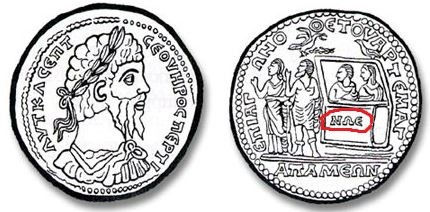
He also raised the status of several Roman settlements of Judean province to 'polis': Beth-Guvrin became Euleuthopolis (meaning city of the freemen), Lydda became Diospolis (city of god), Emmaus/Hammat became Nicopolis (city of victory; in fact, the modern-day sport brand 'Nike' means 'victory'). As a result, these cities were extended with public buildings to entertain their residents and encourage Romans to retire and settle there after their military life. Religious persecutions also enabled the Romans to use Jews (and Christians) in the arena games, as gladiators or as bait for wild beasts. One passage of the Talmud even makes a point that Jewish attendance to Roman games was exceptionally allowed:
For it has been taught: One should not go to stadiums because [they are] ‘the seat of the scornful’, but Rabbi Nathan permits it for two reasons: first, because by shouting one may save [the victim], secondly, because one might be able to give evidence [of death] for the wife [of a victim] and so enable her to remarry. (Talmud, Avoda Zara, 18b)
What were these two reasons? The first one refers to the traditional ending of a gladiator combat: the winner asked the crowd what should be done of the loser; if most of the crowd would shout the word mitte, meaning ‘life’, then his life was spared. At the contrary if they shouted iugula, it meant they wanted his death. And thus, Rabbi Nathan declared that attending the Roman games was permitted to shout for his life. The second reason relates to the fate of the loser in case he gets killed: Jewish law requires witnesses to declare he indeed died otherwise his wife would not be considered a widow and thus could not remarry.
In 202, Septimius Severus endeavored to increase the Roman empire in Northern Africa and, from 208, he also campaigned in Britain beyond the Hadrian Wall. But he died in York (England) in 211. His two sons Caracalla and Geta succeeded him. But the former, the older one, had his younger brother Geta murdered after a few months, so Caracalla reigned alone from the end of 211.
Year 3972 – 212 CE – The Edict of Caracalla
At the beginning of his reign, Caracalla made an unprecedented move by granting Roman citizenship to all free men and women of the Empire whereas, previously, only the citizens of Italy could enjoy such privilege. The motives are unclear but Roman historians assumed it was a means to increase the number of taxpayers, because non-citizens were not obligated to the Roman taxes.
Caracalla, whose real name was Antoninus Augustus, came to the Eastern provinces in 216 to wage a war against the Parthians. He remained for some time in the Levant:
The emperor [Caracalla] then left Troy and traveled through the rest of Asia, Bithynia, and the remaining provinces. After tending to affairs in these regions, he came to Antioch. Given a warm welcome there, he remained for some time. (Herodian, Roman History, 4:8, paragraph 6)
The Talmud has many mentions of the emperor because he held several discussions with the rabbis of the time. The Talmud put him on a high scale by stating:
Rabbi Hama son of Rabbi Hanina said: “Three treasures did Joseph hide in Egypt: one was revealed to Korah; one to Antoninus the son of Severus; and the third is stored up for the righteous for the future time.” (Talmud, Pesachim, 119b)
But Caracalla’s campaign against Parthia was not successful. He was assassinated a year later in 217 by one of his officers in a field near Charan (Northern Syria), when he stopped to urinate.
He was succeeded by Macrinus, a bureaucrat of Berber origin (North Africa) who was also assassinated after a few months in 218. He was succeeded by 14 years old Elagabalus, of Syrian origin by his mother side, who was also assassinated in 222, due to his disregard for religion and morality. He was replaced by his cousin Alexander Severus.
Year 3977 – 217 CE – Death of Judah the Prince
Judah the Prince died in 217 CE (although some say he died in 222 CE). He died in Sepphoris but asked to be buried in Beth-Shearim, his native hometown. After his burial, Beth-Shearim became a necropolis as we can see today by visiting the site in Galilee (see document C33b, year 140 CE). For the following couple of hundred years, other Jews wanted to be buried next to the Sage.
Year 3982 – 222 CE – Alexander Severus
The emperor Alexander Severus was born in a town of modern-day northern Lebanon, which was part of the Roman province of Syria-Palestina and started to reign at the age of 13. So, he was greatly influenced by his mother, of Syrian origin, who educated him for his role and advised him on every affair. On religious matters, he was very tolerant and gave freedom of cult to Jews and Christians in the Empire:
He respected the privileges of the Jews and allowed the Christians to exist unmolested. (Historia Augusta, The Life of Severus Alexander, chapter 22)
He authorized the construction of a synagogue in Rome and gave as a gift a scroll of Torah that had been brought back by Titus from the Temple of Jerusalem in 70. This scroll, which was called Codex Severi, has been lost since. He lived a life of modesty and even adopted the great maxim of Hillel:
When in the field or on a campaign, he lunched and dined in an open tent and ate the soldiers' ordinary food in the sight of all and greatly to their pleasure; and he used to go about to all the tents and never permitted anyone to be absent from the colors. Moreover, if any man turned aside from the road into someone's private property, he was punished in the Emperor's presence according to the character of his rank, either by the club or by the rod or by condemnation to death, or, if his rank placed him above all these penalties, by the sternest sort of a rebuke, the Emperor saying, "Do you desire this to be done to your land which you are doing to another's?" He used often to exclaim what he had heard from someone, either a Jew or a Christian, and always remembered, and he also had it announced by a herald whenever he was disciplining anyone, "What you do not wish that a man should do to you, do not do to him." And so highly did he value this sentiment that he had it written up in the palace and in public buildings. (Historia Augusta, The Life of Severus Alexander, chapter 51)
Year 3995 – 235 CE – The Crisis of the Third Century
But Severus’ reign was also marked by troubles on the borders of the Roman empire, with both Persian and Germanic attacks that resulted in territorial losses for Rome. Severus was assassinated by his own troops in 235 while campaigning in Germany. The reason was that they had lost faith in his leadership after the defeats that the German tribes inflicted to the Roman legions.
This led the Roman Empire to another crisis of succession that has been called by Historians the "Crisis of the Third Century" because it lasted during most of that century, until the year 284, and during which the Empire was divided between various parts, each ruled by different claimants to the emperorship.
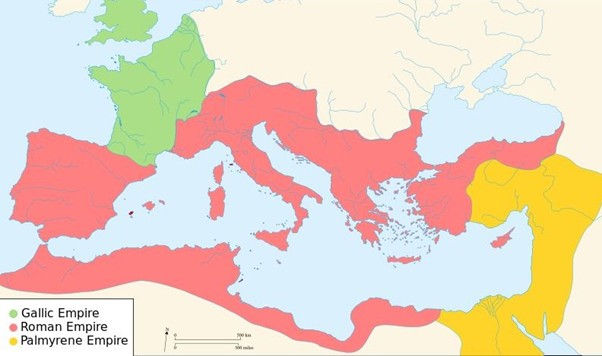
About Year 4000 – 240 CE – The Sefer Yetzirah
Some passages in the Talmud refer to a mystical book of very ancient origin, the Sefer Yetzirah or Book of Creation. For example:
R. Hanina and R. Oshaia spent every Sabbath eve in studying the ‘Book of Creation’, by means of which they created a third-grown calf and ate it. (Talmud, Sanhedrin, 65b, also in 67b)
The Book of Creation was obviously a work known during the Talmudic period as some important rabbis were studying it. It is based on the belief that Creation was done by God using the Hebrew letters. This principle formed a base upon which the Kabbalah was formulated, that each letter is assigned specific mystical powers. The divine utterances during the Creation (such as God said etc.) are these manifestations of the usage of the letters and words, and this was a known oral tradition expressed in the following statement:
Rab Judah said in the name of Rab: Bezalel [the son of Uri, who was tasked by God and Moses to build the Tabernacle, the Ark and the holy vessels] knew how to combine the letters by which the heavens and earth were created. (Talmud, Berachot, 55a)
The origin of the book is so ancient that the Sages ascribed it to Abraham. It has surely been known as oral tradition for a long time and was only committed in writing at the time of danger to lose such tradition once the Jewish nation was no longer in existence. Its written form corresponded to the time of the lives of Talmudists such as Rabbi Hanina and Rabbi Oshaia who studied it. It is also possible that it was committed in writing some time before the end of the fourth millennium from Creation, as a commemoration of God's will to create the world and mankind in it.
One of the principles described in the book is that man is a microcosm of the Creation, so each letter of the alphabet also corresponds to a spiritual or a physical human feature. God used the alphabet of 22 Hebrew letters to create the world, including Shabbat, in 7 days (to understand these 7 days, click here). This was the perfect secret combination because the ratio between the circumference and the diameter of a circle is about 22 over 7. The 22/7 ratio was established in Antiquity, about 250 BCE, at the time of Archimedes, and is good enough human approximation of the number Pi (π) (for further discussion about the number Pi, see document C23b, year 1015 BCE).
And He [the Lord] created His universe with three 'sefarim': with text [sefer], with number [sefar] and with utterance [sippur]. (Sefer Yetzirah, 1:1)
The 'text' refers to the 22 letters of the alphabet, the 'number' to the 10 digits from which every number in decimal base is formed (and 10 is also the Ten Sefirot which are parts of the fundamentals of the Kabbalah), and both together gave the 32 'utterances' that God used in the Creation. Indeed, in the first four chapters of Genesis (until the banishment of Cain), the number of times when God either said, called, commanded, or blessed is 32. The Sefer Yetzirah mentions them as 32 paths. The number 32 is also written as לב [pronounced lev] which means 'heart' in Hebrew, a human organ that gives life by connecting all other organs and body parts to it. The two letters of the word Lev are also the first letter (ב) of the Torah, from the word בראשית (Bereshit, at the beginning), and the last letter (ל) of the Torah, from the word ישראל (Israel).
About Year 4000 – 240 CE – Resh Lakish and the number of stars in the Universe
Rabbi Simeon ben Lakish, well-known in the Talmud as Resh Lakish, was one of the most prominent Amora of the second generation of Amoraim. He was born around 200 CE in the Syro-Roman province, and it is said that he had to fight as a gladiator in his youth, as many other Jews were used in Roman games. He then became religious and moved down to Sepphoris where Judah ha-Nassi had lived. He had therefore been educated under the guidance of the fathers of the Mishna.
In one passage of the Talmud, he made a surprising statement about the number of stars in the Universe, at a time when the naked eye could only see some hundreds of them. Only after Galileo invented the telescope, could astronomers then assess the number of stars to the magnitude of several thousands. But it was not until the early 20th century, when the photographic film was invented, which could record a portion of the sky with long exposure of weak light sources (coming from very remote stars), that the understanding of the number of stars grew to a much larger number, now assumed to be in the range of 1 followed by 20 zeros or more.

Yet, with no telescope and no knowledge, the Jewish Sages only relied on interpretations of the Scriptures. For example, the Bible states:
"As the host of heaven cannot be numbered, neither the sand of the sea measured; so will I multiply the seed of David My servant, and the Levites that minister unto Me." (Jeremiah 33:22)
Here the host of heaven refers to the stars and all stellar objects, meaning that the stars, like the sand, cannot be numbered.
Coming back to Resh Lakish, this is what he stated about 240 CE quoting from what God said of Israel, in a language that they could understand by comparing the size of the Roman army:
My daughter [the community of Israel], twelve constellations have I created in the firmament, and for each constellation I have created thirty hosts, and for each host I have created thirty legions, and for each legion I have created thirty cohorts, and for each cohort I have created thirty maniples, and for each maniple I have created thirty camps, and to each camp I have attached three hundred and sixty-five thousands of myriads of stars, corresponding to the days of the solar year, and all of them I have created only for your sake. (Talmud, Berachot, 32b)
Now, let's do the math’s: according to the above statement, the number of stars is 12 x 30 x 30 x 30 x 30 x 30 x 365,000 * myriads = 1 with 14 zeros of myriads. And what is a myriad? The word is vague enough in the Talmud text which uses רבוא which designates a very large quantity translated as 'myriad' in English. If we take the Greek meaning of myriad (because many Jews understood Greek in these times, as the most used pagan language for science), it means the number 10,000 so it adds 4 zeros to our previous number of stars to reach the very large number of 1 followed 18 zeros. But this is only an approximation based on a supposed translation of the Hebrew word רבוא as a value of 10,000. The exact number of stars is not known today by science, which only offers a very broad range of high numbers. But the point was not to know the exact number. The Hebrew word רבוא only suggests adding a "very large factor" to the number 1 with 14 or 18 zeros. In other words, the Sages of the Talmud already knew, without telescope nor photographic film, that the number of stars exceeded very vastly what the human naked eye could possibly see.
Another example of this knowledge is reflected in the comment made by Samuel, an Amora born in Nehardea (near Babylon) about 165 CE, who was also an astronomer. The discussion was about the understanding of:
Who makes the Bear, Orion, and the Pleiades (Hebrew word כִימָה, pronounced Kimah) and the Chambers of the South? (Job 9:9) What is meant by Kimah [Pleiades, כִימָה]? Samuel said: About a hundred [ke'me-ah כִי מאה] stars. (Talmud, Berachot, 58b)
This comment is astonishing because the Pleiades is a cluster of stars which was believed, since ancient times, to be composed of a handful of stars which could be seen by the naked eye. The Pleiades were even nicknamed the Six Sisters because of their visible six stars. And since the end of the 18th century, astronomers, with the help of telescopes, estimated that the Pleiades contained 64 objects, a number which closer to the Talmudic statement about a hundred.
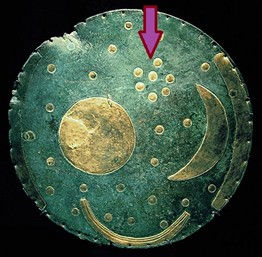
Year 4000 – 240 CE – The new millennium
This 34th generation witnessed the end of the 4th millennium since the Creation. The first two millennia were about the ancestry of all mankind and how the world had populated and saw the emergence of the Jewish people represented by the Patriarchal era. The next two millennia saw the Jewish people rising as a nation among the nations, with golden ages and misfortunes, and concluded with its destruction as a national entity and with its exile.
The next two millennia will see the long march through ages of darkness and persecutions, but with its unlikely survival and ultimate redemption until the Messianic era. These two last millennia are a mystery for those non-Jews who do not understand the nature or the character of Jewry: how can a dispersed "people", with no clear belonging to a race, with no physical borders for such a long period of time, with no ability to always sustain itself in its religious spirituality in the face of ordeals and massacres, could have possibly survived for so long, if it wasn't for an act of God or His will? Moses announced the dispersion of the Jewish people before he died: when he made an address to the Israelites before they entered the land of Canaan:
When you shall beget children, and children's children, and you shall have been long in the land [of Israel], and shall deal corruptly, and make a graven image, even the form of anything, and shall do that which is evil in the sight of the Lord your God, to provoke Him; I call heaven and earth to witness against you this day, that you shall soon utterly perish from off the land whereunto you go over the Jordan to possess it; you shall not prolong your days upon it, but shall utterly be destroyed. And the Lord shall scatter you among the peoples, and you shall be left few in number among the nations, whither the Lord shall lead you away. And there you shall serve gods, the work of men's hands, wood and stone [a reference to Christian and Muslim realms, as wood is the Cross and stone is the Kaaba], which neither see, nor hear, nor eat, nor smell.
But from thence you will seek the Lord your God; and you shall find Him if you search after Him with all your heart and with all your soul. In your distress, when all these things are come upon you, in the end of days, you will return to the Lord your God, and hearken unto His voice; for the Lord your God is a merciful God; He will not fail you, neither destroy you, nor forget the covenant of your fathers which He swore unto them. (Deuteronomy, 4:25-31)
This is how our Sages reflected on the two main communities of Israelites throughout the world, in these early times of the great exile:
Rabbi asked R. Ishmael son of R. Jose: “The wealthy in Palestine, whereby do they merit [wealth]?” — “Because they give tithes,” he replied, “as it is written, ‘Asser te'asser [You shall surely tithe, Deuteronomy 14:22] [which means], give tithes [‘asser] so that you may become wealthy [tith'asser].” “Those in Babylon, wherewith do they merit [it]?” — “Because they honor the Torah,” replied he. “And those in other countries, whereby do they merit it?” — “Because they honor the Sabbath,” answered he. (Talmud, Shabbat, 119a)
This new ordeal that the Israelites will have to go through will be a long exile out of the land of the divine promise:
Our Rabbis taught: When our Masters entered the vineyard at Yavneh [a metaphor for the school that Yohanan ben Zakkai opened during the siege of Jerusalem, see document C32c, year 69], they said, The Torah is destined to be forgotten in Israel, as it is said, "Behold, the days come, says the Lord God, that I will send a famine in the land, not a famine of bread, nor a thirst for water, but of hearing the words of the Lord." And it is said, "And they shall wander from sea to sea, and from the north even to the east; they shall run to and from to seek the word of the Lord and shall not find it." (Amos 8:11-12). (Talmud, Shabbat, 138b)
The main danger of the diaspora has always been, and still is, assimilation. Because it would cause the melting of the Jewish people into the peoples of the earth and therefore its disappearance as an entity:
R. Simeon ben Elazar said: "The Israelites who live outside of Palestine are unconsciously worshipping idols. How so? An idolater gives a feast in honor of his son and he invites all the Jews of the place, and although they eat and drink of their own, and their own servants wait on them, yet it is considered as if they had eaten the sacrifices of the dead, as it is written: 'Any one call you and you eat of his sacrifice.' [Exodus 34:15]" (Tosefta Avot de-Rabbi Nathan, in Rodkinson, Michael, The Babylonian Talmud, Volume I (IX), page 94, publ. 1900)
But, at the same time of the great diaspora, the Jewish people had a written code of laws, with the Mishnah, which enabled them to strengthen their knowledge about the divine commandments and find solace in the relationship they had with God. By maintaining His commandments, they could find a goal to their own existence and could survive the ordeals that their exile will cause them in the generations to come.
And what was going to happen to the land of Israel in absence of its Jews? Here again the Scripture states the word of God on this matter:
And I will bring the land into desolation; and your enemies that dwell therein shall be astonished at it. And you, will I scatter among the nations, and I will draw out the sword after you. And your land shall be desolation, and your cities shall be a waste. Then shall the land be paid her sabbaths, as long as it lies desolate, and you are in your enemies' land; even then, shall the land rest, and repay her sabbaths. As long as it lies desolate it shall have rest; even the rest which it had not in your sabbaths, when you dwelt upon it. (Leviticus 26:32-35)
And indeed, foreign people who conquered the land of Israel could never turn it into a productive land as it had been in the days of the Jews. The land laid waste. Until the end of the 19th century when it started to blossom again upon the return of Jews.
Around Year 4000 – 240 CE – The Jewish Diaspora
The fall of the Jerusalem did not mean the end of the Jewish nation. Long before Roman times, many Jews were already living in various parts of the known world and this diaspora started over 1000 years before the Roman exile. Let's look at the various periods of exiles.
Around 1000 BCE
The first diaspora started in the period of the Judges, when Israelites from the 12 Tribes living next to the Phoenicians started to travel the Mediterranean Sea on board their ships looking for commerce and import to the Levant. So, the first Jews established themselves at the ports of the Phoenician trade and explored the local regions from there, while the Phoenicians mainly focused on the maritime transport and trade levies they would take from Jewish explorers and merchants.

Of course, many of these early Israelite settlers ended up totally disconnected from Jewish life over the centuries and were absorbed in the melting pot of subsequent population migrations and mixed with them. Yet, Genetics offers us a glimpse of what happened in these times because we can find small pockets of populations with a genetic pattern that could only be explained by this early Israelite diaspora. For example, while most of European male Y-genes are of the R haplogroup, we can find locations where the haplogroup is Q. And this haplogroup is of Asian origin, meaning for this time, it came from the Jewish forefathers who originated from Mesopotamia (part of Asia). Phoenicians cannot recount for this Q haplogroup because they were Canaanite people thus of E haplogroup. The Q haplogroup, in the context of these early people migrations, can only be explained by the presence of these early Israelite settlers, mostly in places around the Mediterranean Sea of course, but also in the Basque population, in the Celt population (especially in the Cornwall region which was rich of tin resource, which was extremely useful to make metal), and even in the Dane and Nordic population (which gave root to the Vikings). Of course, as we are talking about some settlers, the Q haplogroup group does not represent most of a genetic mix of any given region, but it does represent a certain proportion of the concerned population. And, in Northern Africa, the Q haplogroup is no longer present because the Q carriers, which were Jews, had emigrated from that region since the creation of the State of Israel and established themselves there (or in France, for most of the Algerian Jews). In the map below, we can notice the presence of Q in the north-east of England, but this is easily explained by invasions of the Vikings (carriers of Q haplogroup) in that region in the Middle Ages.
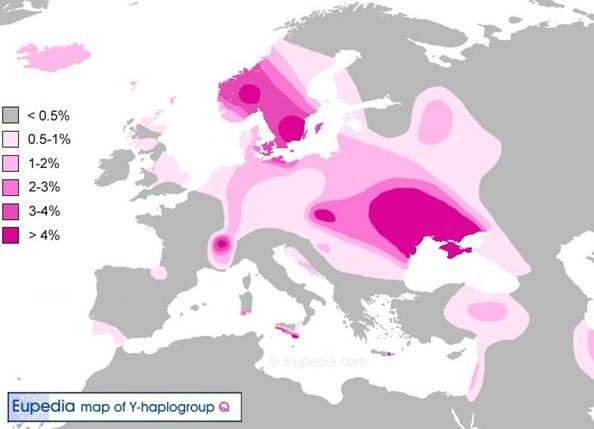
Out of these early Israelite settlers, none of them retained their Jewish culture except for those established in the Mediterranean Sea who were close enough to their homeland to keep their customs. In particular, the Israelites established themselves in Northern Africa around 1000 BCE and founded, with their Phoenician maritime partners, the city of Carthage around 800 BCE. Before them, another Canaanite maritime nation came to the region: the Girgashites. We know this from two different sources. The first one is a tradition stated in the Midrash:
R. Samuel ben R. Nahman said: What did Joshua do [before the conquest of Canaan]? He published an edict in every place he came to conquer wherein was written: Whosoever desires to go, let him go; and whosoever desires to make peace, let him make peace; and whosoever desires to make war, let him make war. What did the Girgashite do? He turned and went away from before them [the Israelites]. And God gave him another land, as beautiful as his own, namely, Africa. (Deuteronomy Rabbah, V,14)
The second one is a testimony from Procopius of Caesarea, a Byzantine historian of the 6th century CE. He wrote the following account:
Now when these [Canaanite] nations saw that the invading general [Joshua] was an irresistible prodigy, they emigrated from their ancestral homes and made their way to Egypt, which adjoined their country. And finding there no place sufficient for them to dwell in, since there has been a great population in Egypt from ancient times, they proceeded to Libya. And they established numerous cities and took possession of the whole of Libya as far as the Pillars of Heracles [Gibraltar], and there they have lived even up to my time, using the Phoenician tongue. They also built a fortress in Numidia [Northern Africa], where now is the city called Tigisis [in present-day Western Algeria]. In that place are two columns made of white stone near by the great spring, having Phoenician letters cut in them which say in the Phoenician tongue: "We are they who fled from before the face of Joshua, the robber, the son of Nun." (Procopius of Caesarea, "De Bello Vandalicom", The Vandalic War, IV, x,22; to read the text online, click here)
But Procopius was wrong about one detail: the Girgashites didn't go as far as the Pillars of Hercules. They settled around 1250 BCE in what is Libya today. The Phoenicians established themselves in what became the city of Carthage. The name Phoenician comes from the Greek Phoinikes which came from the word phoinix which means "purple". This is because the Phoenicians, who rather called themselves Canaanites from the cities of Sidon and Tyre, were traders of the rare purple dye in the Antiquity. In Hurrian, a semitic language using cuneiform, the name Canaan means "land of the purple". So, the Greeks simply called these maritime people the Phoenicians as a mere translation of the way these people called their land, Canaan, which meant purple. As of the name Carthage it comes from the Hebrew and semitic word Kyriat Hadash, which means "new city".
So, when the Israelites who came with the Phoenicians around 1000 BCE saw the Canaanite people already established there on the east of the Phoenician port which was called Carthage, they avoided any contact with them and ventured west in what is now the Maghreb. The customs were quite different between the Israelites established at the west compared to the Canaanites established at the east. For example, the Israelites emulated the way they were organized in their home land: tribes with a spiritual leader called a judge (shofet in Hebrew). The same was actually adopted in the city of Carthage since its foundation: the city was ruled by shoftim, meaning magistrates in their language. But, in the east, the Canaanites established in present-day Libya were ruled by a king or champion, which was called agellid in their language. The word agellid is the root for the name ‘Goliath’, the famous Philistine warrior who was killed by David (see document C23b, year 1060 BCE). The same word has been borrowed by the Greeks to form the word aegis, which means protection or protector.
So, Israelites established in Carthage and at the west of the city in the region now called the Maghreb. Where does this name come from? The Greek Herodotus who lived around 500 BCE named the people who lived there the Maxues, stating that they called themselves like that. Later on, the Greek language adapted the name into Maurosioi, which meant the People of the West, from the Phoenician word Mahourim which had the same meaning. Then the Romans adapted this name into Mauri, which gave Mauro in Spanish and Moorish in English. The term Mahourim was used by the Phoenicians to call the people living at the west of Carthage, the Israelites. The word is identical to the Hebrew Maharavim, which means the People of the West. So, the word Maghreb originates from the Hebrew Maarav. When the Arabs invaded this region 1500 years later, they called it the Djazirat-el-Maghreb, which means the Island of the Sunset (West).
The Assyrian deportations, around 750-700 BCE
Less than 100 years after the foundation of Carthage, all the Levant region (except for Judea and Jerusalem), was invaded and destroyed by the Assyrians. Some Israelites escaped with the Phoenicians on their ships and found refuge in the largest colony of the Phoenician maritime trade, Carthage. But most of the populations were deported to the outskirts of the Assyrian empire, and some Israelites were taken to Nineveh to work for the Assyrian power (the Book of Tobit is a testimonial of this).
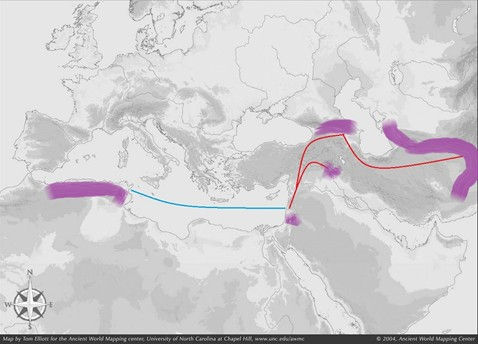
The Babylonian exile, around 600 BCE
The Assyrian empire was conquered by Nebuchadnezzar some 150 years later, around 600 BCE. The Israelites originated from the Ten Tribes fled the theatre of destruction to farther lands, eastwards to what became Parthia and Media, and even as far as what became Afghanistan (which was in majority populated by people of Jewish origin, the Pashtuns ethnics, before the advent of Islam). Those established in the northern part of the Assyrian empire fled farther north and into what became Armenia and Scythia.
Then Nebuchadnezzar conquered the kingdom of Judah and destroyed Jerusalem. He took to captivity in Babylon the most prominent Jews of this time. Some of the Judeans fled into Egypt to avoid being taken captives to Babylon.
In parallel, the Israelites established in Carthage continued to flourish and busied themselves with the building of a maritime empire with their hosts the Phoenicians (now called the Carthaginians). Those kept their Jewish traditions whereas the Ten Tribes were mostly assimilated because they had adopted pagan gods already at the time of the Kingdom of Israel.
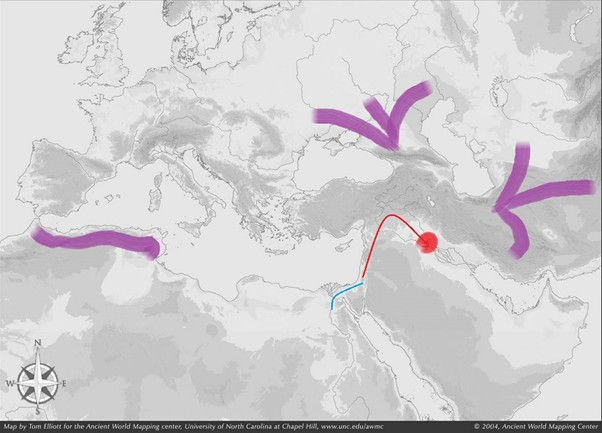
The Persian rule, around 450-350 BCE
Babylon fell to the Persian king Cyrus the Great who authorized the captive Jews to return to their homeland. But this return to Sion only became important after the events of Esther and Haman, some 100 years after the exile in Babylon. Most of the Jews however preferred to remain in the Persian empire and developed large communities in the newly ruled realm. The Persians also destroyed Egypt and ended the native dynasties. In the meantime, the Carthaginian maritime empire continued to flourish on the shores of the western side of the Mediterranean, thus avoiding conflict with the Greeks and Persians who fought one against the other in these times in the eastern side of the Mediterranean Basin.

The Hellenization, around 350-100 BCE
Following the conquest by Alexander the Great in 333 BCE, the Greek rule spread from Egypt and Greece until Persia. All Jewish populations of the previous Persian empire passed under Hellenism. And, as the Greeks started to build new cities to established themselves in these centers of power, many Jews flocked into these new opportunities and lived in Alexandria (Egypt) and Antioch (Syria), and in the Greek homeland as well as in the Greek harbors of Asia Minor.
As of the Jews who went further east towards Afghanistan, they continued to keep some of their customs but converted to Islam some 1000 years later. These were truly "Lost Tribes".
The Jews who remained in Scythia continued, like their brethren of North Africa, to keep their Jewish culture and traditions, and managed to remain away from wars and changes of empires that took place in Mesopotamia, Levant and Egypt.

But, soon after, a new military power, Rome, started to contest these empires, Carthaginian in the west then Greek in the east.
The fall of Carthage, around 200 BCE
After about 600 years of existence, Carthage became the target of the Roman appetite for expansion. The wars between Rome and Carthage took several turns. At some point, the Carthaginian general Hannibal, whose name means Ani-Baal, I am the Lord, was close to destroying Rome after a long siege but had to return to Carthage.
The Roman general Scipio chose that moment of weakness to cross the sea and gave a final blow to Hannibal in 202 BCE at the battle of Zama: this was the end of the Carthaginian empire. Many Jews fled the destruction and Roman enslavement by going west and in the mountains of the Atlas where the Roman legions couldn't make easy progress. In fact, Rome managed to control the coastal plains but never the mountain range of North Africa. At the same period, the Greek empire was weakening under the attacks from the east and from the north, and had to let Judea, for example, gain independence after the revolt of the Maccabees.
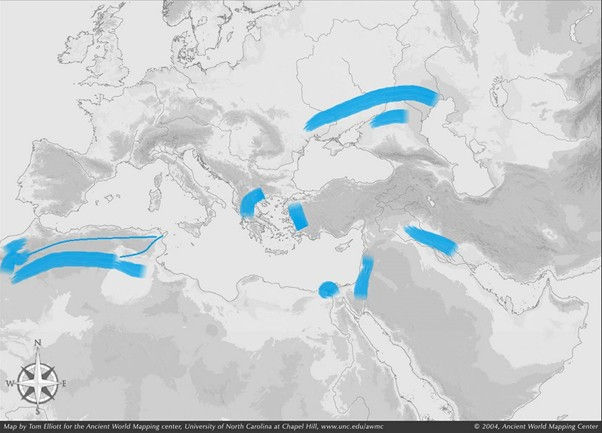
The Roman rule, from around 40 BCE
After conquering the western side of the Mediterranean Sea, Rome turned their attention to the opposite direction and came into conflict against the various Hellenistic kingdoms established after the death of Alexander the Great. The disputes among the Hasmonean dynasty of Judea led Rome to take side and contributed to the rise of Herod into power in 40 BCE as King of the Jews. Meanwhile Rome gradually conquered Greece, Egypt and the rest of the Hellenistic dominions until they came against the same enemies than the Greeks faced: the Persians/Parthians in the east and the Scythians in the north. In their empire however, they were rather tolerant towards the Jews and many of them moved into the vast Roman empire in search for peaceful lands and business to pursue. Jews moved to Italy, Spain, Gaul and Helvetia, in addition to Ptolemaic Egypt and Seleucid Syria. By the time of the destruction of the Second Temple, Diaspora Jews were already all over the Roman empire.
In Egypt for example, Philo of Alexandria stated the following:
Jews who inhabited Alexandria and the rest of the country from the Catabathmos on the side of Libya to the boundaries of Ethiopia were not less than a million of men. (Philo, Flaccus, VI,43)
This amount of people represented about 12% of the total population of Egypt but most of them were concentrated in Alexandria, a city with five boroughs, three of them being populated by Jews !
Even Rome had its Jews, before the destruction of the Second Temple. It has been assessed that about 50,000 Jews lived in Rome at that time, and they had 11 synagogues. They spoke Greek and lived in the Trastevere borough, on the other side of the Tevere river. Some catacombs of Rome had been used by Jews since the time of the Hasmonean dynasty in Judea, about 200 years before the common era.
The War of the Jews has cost the life of one million people in Judea and in Jerusalem. After the fall of Jerusalem, Titus sent about 100,000 Jews as slaves in the eastern provinces of the empire, and took some back to Rome, where a Jewish population was already firmly established.

In the outskirts of the Roman empire, where the conquest had not been successful, some Jewish populations were able to retain their identity and traditions. This was mainly the case of the descendants of the early Israelites settlers in North Africa, as they kept refuge in the mountain range and didn't mix neither with the Romans nor the Judeo-Romans (those who came as part of the Roman empire) who lived in the coastal plains. It was also the case of the Jews of Scythia because Rome had never managed to completely vanquish that part of the world.
From 200 CE, Rome came under the threat of the German "barbarians", who had managed to stop their conquest. In the meantime, Christianity started to spread in the Roman empire, with ups and downs in term of persecution because Christians were considered by the Romans as being a threat to their authority (mostly because they endeavored to enroll followers, secretly), unlike the Jews who represented no threat (as they were not actively converting the Roman population to the Jewish faith).
The Scythians were descendants of Ashkenaz, son of Gomer son of Japheth son of Noah (see document C16). The first Jews living among them were nicknamed Ashkenazim. They moved with the Scythians into Central Europe and were later joined by other Jews who came from the Roman empire after its collapse. So, in fact the Ashkenazim Jews had two origins: the most ancient ones came to Central Europe with the Scythians, whereas the vast number came from the Roman empire. The existence of a strong Jewish community among the Scythians, and dating back from the Assyrian invasion, is proven by tombstones found in Crimea and dating from the new CE era. One of such tombs reads:
This is the tombstone of Buki, the son of Izchak the priest. May his rest be in Eden at the time of the salvation of Israel. In the year 702 of the years of our exile. (Pain, H. Herbert, Englishmen Israelites, 1897, p.15)
And for those Jews who followed religious commandments, the end of the nation as a political entity did not mean the end of their faith. The Sages had predicted that God will punish His people but, at the same time, will not destroy them utterly. For this, they would recall the covenant that God made with Abraham:
Said Abraham before the Holy One, blessed be He: “Sovereign of the Universe, perhaps God forbid, Israel will sin before You and You will do to them as You did to the generation of the Flood and the generation of the Division [Babel]?” He answered, “Not so.” He then said before Him: “Sovereign of the Universe, by what shall I know this?” He said: “Take me a [sacrificial] heifer of three years old,” etc. He then said before Him: “Sovereign of the Universe, this is very well for the time when the Temple will be standing, but in the time when there will be no Temple, what will befall them?” He replied to him: “I have already fixed for them the order of the sacrifices. Whenever they will read the section dealing with them, I will reckon it as if they were bringing me an offering and forgive all their iniquities.” (Talmud, Megillah, 31b)
In other words, the reading of the section of the Torah related to the sacrifice in the Temple would be as valuable for God than the sacrifices themselves. Redemption will occur by keeping knowledge and reading of the “book” in times when the Temple no longer stood.
However, as God had said by the mouth of Moses, the Jews of Diaspora shall fear night and day, and shall have no assurance of life (Deuteronomy 28:66). This was because, wherever the Jews settled outside the promised land, they were subjects to periods of hatred, vexations, restrictions, and so on, despite the periods of peace that occurred on other occasions. It is interesting to also note the similarity between the chronological generations 17 and 34, the latter seeming to be a repetition of the former. In generation 17 (see document C17), God intervened in the affairs of the world and dispersed humanity after the Tower of Babel. It was this generation that signaled the change of direction that His Creation took: a new era started after two millennia. Similarly, in the present generation 34 (twice 17), God dispersed His chosen people, but at the same time a new era started which, with the Diaspora, reinforced the Jewish people in their faith and in the hope of the final redemption. This redemption will start precisely after the 50th generation, and the beginning of a new era with the 51st generation (three times 17). This cycle of three will make the Creation complete, as signaled by the number 3 (to read about Jewish symbolism in the numbers, click here).
Year 4004 – 244 CE – The synagogue of Dura-Europos
The Roman city of Dura-Europos at the border of modern-day Syria and Iraq had a large Jewish community. This is testified by the ruins of a synagogue that have been found by an archaeological dig in 1932.
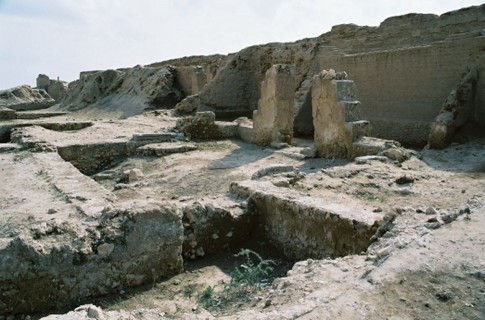
The synagogue was richly decorated with frescoes of Biblical scenes. They are now displayed at the National Museum of Damascus in Syria.

Year 4045 – 285 CE – Diocletian divides the Empire
A Roman army commander, Diocletian, managed to end the crisis that plagued the Roman Empire in the third century by establishing the model of Tetrarchy, whereas the ruling of the empire was divided between four individuals. Diocletian's last opponent was defeated in July 285, and this victory secured his ruling model for the empire. This date marked the moment when the Roman Empire began to divide, primarily between Western and Eastern empires.
Year 4060 – 300 CE – Diocletian divides Judea
Diocletian also had success against the enemies of Rome at the borders of the empire. He also reorganized the empire with new administrative centers. For example, the province of Syria-Palaestina was divided into:
Palaestina Prima (Judea, Samaria, Idumea, Peraea and the coastal plain) with Caesarea as capital
Palaestina Secunda (Galilee, the 10 cities of the Decapolis, Golan heights) with Scythopolis (former Biblical Beit-shean) as capital
Palaestina Tertia (the Negev desert and the Arabia province) with Petra as capital
This division remained the same until the Byzantine Empire.

To prevent attacks from the neighboring desert tribes, called Sarrasins, he also ordered to build several forts along the border with the Arabian desert: this line of forts was called the Diocletian Limes, although the work had started at the time of Trajan. In line with this new defense policy, Diocletian moved the X Legion Fretensis, which had been stationed in Jerusalem (Aelia Capitolina) since the destruction by Titus in 70 CE, to the Red Sea fort (Aqaba or Eilat) in 300 CE.
Year 4063 – 303 CE – Persecutions of the Christians
The Christians had been discriminated during the reigns of some of the Roman emperors but not as much persecuted as in the time of Diocletian who issued a series of decrees against the followers of this faith. According to estimates, the persecutions that followed and lasted until the reign of Constantine took the lives of about 3500 Christians.

Year 4073 – 313 CE – Constantine and the Edict of Milan
After the death of Diocletian in 311, the Empire went into political instability again. At the end of 312 CE, Constantine won a decisive battle against the last contender for the empire, Maxentius, at the Milvian Bridge. This is where, according to Christian tradition, he had a vision before the battle: he saw the sign of the Christian cross and the message in hoc signo victo vinces (in this sign you will vanquish). This final victory paved the way for him to become the sole emperor of the Roman Empire, thus ending the period of the Tetrarchy for a certain time.
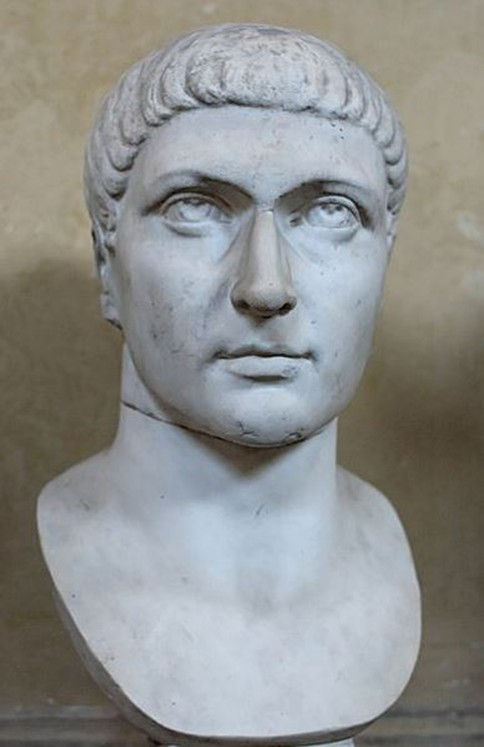
His reign was a turning point in the religious affairs too because, in 313, he decreed the Edict of Milan by which Christianity became an authorized religion in the empire, in addition to other existing religions. It was said that this change was mostly due to his mother, Helena, who was influenced by Christianity.
The new policy paved the road for the building of churches throughout the Roman provinces, not only in the holy land as Helena directed.
Year 4075 – 315 CE – The New Testament
In 315, Athanasius, the Bishop of Alexandria, finalized the list of books to be included as Christian scripture. This list of books is composed of the following 27 books: Matthew, Mark, Luke, John, Acts, Romans, Corinthians I & II, Timothy I & II, Titus, Philemon, Hebrews, James, Peter I & II, John I & II & III, Jude, Revelation. In total, the Old and New Testaments represent 66 books.
Later, in 331 CE, Constantine ordered Eusebius, the bishop of Caesarea, to compile these books into one and make 50 copies of it to distribute to each bishopric (diocese) of the empire. This became known as the New Testament and was a major step for Christianity to become the official religion of the Empire. But it was done at the expense of destroying many other texts and gospels which were discarded from the official canon.
Previous page < Navigation > Next page
To return to the list of chronological generations from Seder Olam Revisited, click here.
Albert Benhamou
Private Tour Guide in Israel
Tishri 5786 - September 2025


